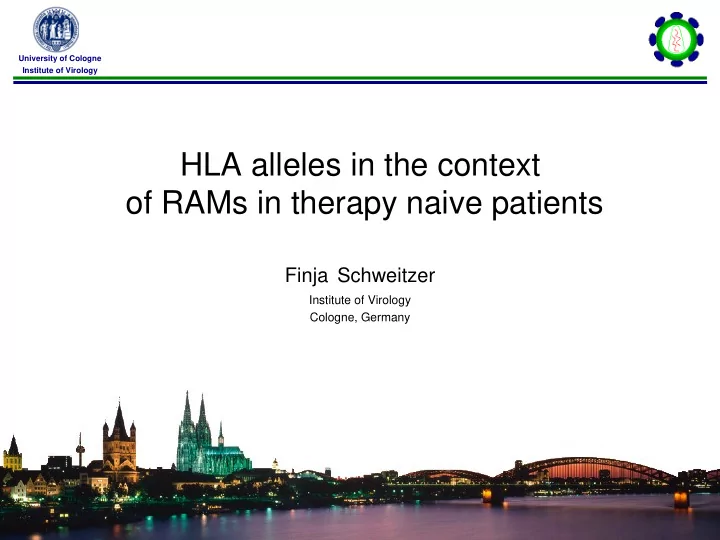

University of Cologne Institute of Virology HLA alleles in the context of RAMs in therapy naive patients Finja Schweitzer Institute of Virology Cologne, Germany 10th AREVIR-GenaFor-Meeting Bonn, 2010, Finja Schweitzer
Background University of Cologne Institute of Virology Human leukocyte antigen (HLA) class I molecules present viral peptides on infected cells to cytotoxic T cells (CTLs) 10th AREVIR-GenaFor-Meeting Bonn, 2010, Finja Schweitzer
Background University of Cologne Institute of Virology viral peptides are 8-10 amino acids long defined for each HLA type (specific anker & recognition site) 10th AREVIR-GenaFor-Meeting Bonn, 2010, Finja Schweitzer
Background University of Cologne Institute of Virology HLA types, which are associated with a high viremia and fast progression of disease HLA-A1-B8-DR3, B37 due to: ineffective presentation on HLA molecules ineffective recognition by CTLs immune escape mutants 10th AREVIR-GenaFor-Meeting Bonn, 2010, Finja Schweitzer
Background University of Cologne Institute of Virology T cell T cell CTL TCR CTL EG MN TCR L M NLP P GR W E E GR W HLA class I HLA class I molecule molecule Antigen-presenting Antigen-presenting cell cell 10th AREVIR-GenaFor-Meeting Bonn, 2010, Finja Schweitzer
Background University of Cologne Institute of Virology T cell T cell CTL CTL TCR TCR E E M NLP E E M NLP GR W Y R W HLA class I HLA class I molecule molecule Antigen-presenting Antigen-presenting cell cell 10th AREVIR-GenaFor-Meeting Bonn, 2010, Finja Schweitzer
Background University of Cologne Institute of Virology Pressure of immune system and drugs on the same sequence: Infectious Agent: HIV Immune Response Inhibition Escape Drug Mutant Resistance Therapy: Antiretrovirals Host: Human 10th AREVIR-GenaFor-Meeting Bonn, 2010, Finja Schweitzer
Aim University of Cologne Institute of Virology Influence of RAMs on the immune system Identification of immune escape mutants among RAMs 10th AREVIR-GenaFor-Meeting Bonn, 2010, Finja Schweitzer
Methods and patients University of Cologne Institute of Virology • HLA-A, -B and –C typing of 139 RESINA patients (with primary RAMs) • Correlation of HLA alleles and mutations within PR and RT • Using epitope prediction server (netmhc) to identify potential epitopes • Analysis of clinical data 10th AREVIR-GenaFor-Meeting Bonn, 2010, Finja Schweitzer
Results University of Cologne Institute of Virology PR: RT: # of correlated mutations 10th AREVIR-GenaFor-Meeting Bonn, 2010, Finja Schweitzer
Results 1 – Correlation PR University of Cologne Institute of Virology Specific mutations could be assigned to HLA alleles: 10th AREVIR-GenaFor-Meeting Bonn, 2010, Finja Schweitzer
Results 1 – Correlation RT University of Cologne Institute of Virology 10th AREVIR-GenaFor-Meeting Bonn, 2010, Finja Schweitzer
Results 2: Epitope prediction PR University of Cologne Institute of Virology reference sequence: TGADDTVLEE M SLPGRWKPKM Protease: M36I potential epitope: HLA-A*03: WB M SLPGRWK HLA-A*03: WB E M SLPGRWK HLA-A*03: WB M SLPGRWKPK HLA-A*30: WB M SLPGRWK HLA-A*30: SB M SLPGRWKPK reference sequence: GADDTVLEEM S LPGRWKPKMI Protease: S37D/N potential epitope: HLA-B*44: WB EEM S LPGRW reference sequence: Protease: M46I/L MSLPGRWKPK M IGGIGGFIKV potential epitope: HLA-A*03: WB M IGGIGGFIKV HLA-A*03: SB K M IGGIGGFIKV reference sequence: Protease: V82A IGTVLVGPTP V NIIGRNLLTQ potential epitope: HLA-A*02: WB VLVGPTP V HLA-A*02: WB VLVGPTP V NI 10th AREVIR-GenaFor-Meeting Bonn, 2010, Finja Schweitzer
Results 2: Epitope prediction RT University of Cologne Institute of Virology reference sequence: EPFRKQNPDI V IYQYMDDLYV RT: V179D/E potential epitope: HLA-Cw*07: WB QNPDI V IY HLA-Cw*07: SB QNPDI V IYQY HLA-Cw*07: WB KQNPDI V IY HLA-Cw*07: SB KQNPDI V IYQY reference sequence: RT: L210F TKIEELRQHL L RWGLTTPDKK potential epitope: HLA-B*44: WB EELRQHL L RW RT: I329L reference sequence: YDPSKDLIAE I QKQGQGQWTY potential epitope: HLA-B*44: WB AE I QKQGQGQW 10th AREVIR-GenaFor-Meeting Bonn, 2010, Finja Schweitzer
Results 3: Clinical data analysis University of Cologne Institute of Virology vs Specific HLA type w/ specific mutation Specific HLA type w/out specific mutation CD4 cell count, viral load (at time point of 1st positive test) Δ Days (time between 1st positive test and therapy start) 10th AREVIR-GenaFor-Meeting Bonn, 2010, Finja Schweitzer
Results 3: Clinical data analysis University of Cologne Institute of Virology 10th AREVIR-GenaFor-Meeting Bonn, 2010, Finja Schweitzer
Results 4: Follow up University of Cologne Institute of Virology vs Specific HLA type w/ specific mutation Specific HLA type w/out specific mutation CD4 cell count, VL (Median time between time points: 2-3 months) 1st positive test 2nd time point 1st time point 3rd time point 10th AREVIR-GenaFor-Meeting Bonn, 2010, Finja Schweitzer
Results 4: Follow up University of Cologne Institute of Virology 10th AREVIR-GenaFor-Meeting Bonn, 2010, Finja Schweitzer
Conclusion University of Cologne Institute of Virology • RAMs could be assigned to specific HLA alleles • Epitopes were predicted within regions of RAMs • Trends could be seen between CD4 cell counts / VL of two compared groups 10th AREVIR-GenaFor-Meeting Bonn, 2010, Finja Schweitzer
Thank you! University of Cologne Institute of Virology Martin Däumer Institute of Immunolgy and Genetics, Bernhard Thiele Kaiserslautern Thomas Harrer Department of Medicine III, Sandra Müller University Hospital of Erlangen Stefan Reuter Dept. of Gastroenterology, Björn Jensen University of Düsseldorf Mark Oette Klösterchen Hospital, Cologne Stefan Esser Department of Dermatology, Jens Verheyen HIV/HBV group University Hospital of Essen Maria Fraune Institute of Virology, Nadine Sichtig University of Cologne Eugen Schülter Claudia Müller Dörte Hammerschmidt Monika Timmen-Wego The RESINA-study group Saleta Sierra-Aragon Eva Heger Elena Knops Melanie Balduin Susanna Trapp Rolf Kaiser Herbert Pfister 10th AREVIR-GenaFor-Meeting Bonn, 2010, Finja Schweitzer
Recommend
More recommend